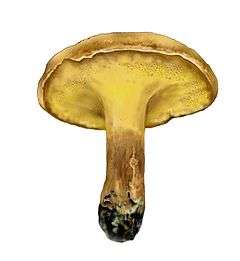Gyrodon
Gyrodon is a genus of pored mushroom bearing close affinity to the genus Paxillus. Recent molecular research has confirmed this relationship of the two genera as sister taxa, together diverging as one of the most basal lineages in the Boletineae, and sister to the Boletaceae.[3][4]
| Gyrodon | |
|---|---|
 | |
| Gyrodon lividus | |
| Scientific classification | |
| Kingdom: | |
| Division: | |
| Class: | |
| Order: | |
| Family: | |
| Genus: | Gyrodon Opat. (1836) |
| Type species | |
| Gyrodon sistotremoides Opat. (1836) | |
| Synonyms[1] | |
Gyrodon was circumscribed by German botanist Wilhelm Opatowski in 1836.[5]
Species
As of September 2015, Index Fungorum lists 13 species of Gyrodon.[6]
- Gyrodon adisianus — Brazil
- Gyrodon africanus
- Gyrodon bohemicus
- Gyrodon crassipes — Ethiopia
- Gyrodon cupreus
- Gyrodon housei
- Gyrodon intermedius — Africa, Madagascar
- Gyrodon lividus — Type species, Europe
- Gyrodon minutus — Asia
- Gyrodon miretipes — Burundi
- Gyrodon ripicola
- Gyrodon smotlachae
- Gyrodon rubellus
- Gyrodon tennesseensis — USA
gollark: 1. using a thing using a slow key derivation function2. encrypting some data just to decrypt it on the server when really you can just send the client random data pointing to some value in a serverside map or whatever
gollark: Also, you're doing it wrong.
gollark: Except you're using it wrong, and it probably slows you a lot, and most stuff should support AES or it's broken, and it's not been updated since july.
gollark: Yes, that is also bad.
gollark: Then you should use a faster encryption library, and also go to a company which allows you to remove technical debt.
References
- "Gyrodon Opat. 1836". MycoBank. International Mycological Association. Retrieved 2011-12-03.
- Heim R. (1966). "Breves diagnoses latinae novitatum genericarum specificarumque nuper descriptarum. Deuxième série". Revue de Mycologie (in French). 31: 150–9.
- Kretzer A, Bruns TD (1999). "Use of atp6 in fungal phylogenetics: an example from the Boletales" (PDF). Molecular Phylogenetics and Evolution. 13 (3): 483–492. doi:10.1006/mpev.1999.0680. PMID 10620406. Archived from the original (PDF) on 2007-07-15. Retrieved 2008-08-02.
- Binder M, Hibbett DS. (2006). "Molecular systematics and biological diversification of Boletales". Mycologia. 98 (6): 971–81. doi:10.3852/mycologia.98.6.971. PMID 17486973.
- Opatowski W. (1836). Vergleichende Morphologie und Biologie der Pilze, Mycetozen und Bacterien (in German). 2. Leipzig, Germany: Englemann. p. 5.
- Kirk PM. "Species Fungorum (version 28th September 2015). In: Species 2000 & ITIS Catalogue of Life". Retrieved 2015-10-06.
This article is issued from Wikipedia. The text is licensed under Creative Commons - Attribution - Sharealike. Additional terms may apply for the media files.